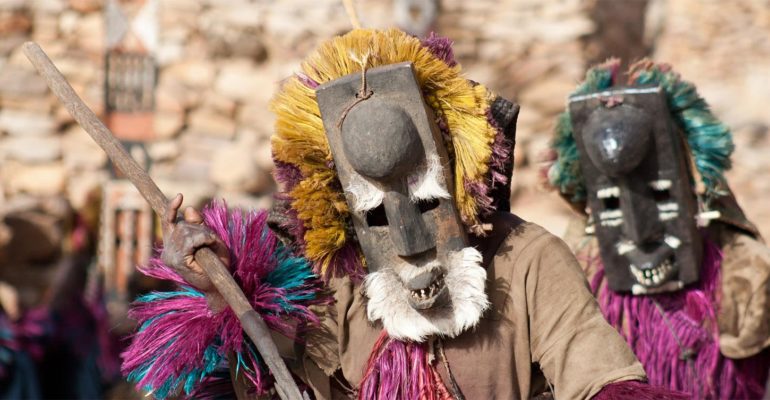Masquerades are traditional events, involving masked dancers that embody different spirits. They happen during festivals, ceremonies, or rituals and can involve songs, dances, drama, and poetry. Masquerades reclaim the African heritage that was lost during colonial times, by embracing the spirit of African culture and customs and giving meaning to aspects of Africa’s history.
The origins and use of the mask
The use of tribal masks in celebrations, rituals, and ceremonies is deeply rooted in African history and culture, dating back even to the Stone Age. The design of the mask represents different tribes and regions, and its use is hugely significant in many cultures in western and central Africa. Wearing the mask can signify a deep spiritual connection as the wearer acts as a kind of medium. This usually means communicating with ancestors and spirits, representing their community in doing so. They call on the spirits for blessings and guidance to help them through events such as marriage, burial ceremonies, and the harvest.
The form of the masks
Most masks are made of carved wood and feature engravings, such as the one created by the Dogon people of Mali, pictured above. Others are made of bronze, terracotta, animal skins, bark, woven cloth, or plant fibres. They are decorated with bone, coloured beads, or cowrie shells to provide texture. The majority are either made of wood or use wood in some way, as it is believed that the tree has a spiritual soul, and so its wood makes a home for the spirit in the mask. The colour of the masks comes from natural dyes from vegetables, plants, or seeds.
Masquerade dancers
The dancers perform either to embody a spirit, to call on ancestors, or simply to entertain. The style of the dance depends on which kind of mask is used. In Nigeria, the Afemai people of Bendel State perform Ikpelweme ancestral masquerades, wearing elaborate headpieces in a more fast-paced style of dance. The Epa masqueraders of the Ekiti-Yoruba wear heavy helmet masks and are limited in their movements. Simple and flowy cloth costumes like that of the Igbomina-Yoruba people in their ancestral Egungun Elewe allow for freer movements that can be much more acrobatic. Animal masks are also used, mostly for ceremonies that ask for support in the fertility of the land during harvest. Carvings of antelope masks are used in Mali. The Bambara people attempt to imitate the movements of antelopes and other wild animals in their dances.
The social role
Dance and music helped form the groups and leaders of African communities. They represent the essence of African civilization and culture. In Yorubaland, during the ceremony of the crowning of an oba (king), the ruler must lead a procession through the town, dancing. Various members of the community greet him as he goes past, each one with their dance rhythm. The dances are also used for educational purposes. Through repetition, they teach children memory and help with physical strength.
Conclusion
Masquerades in Africa are used to celebrate the crowning of a new king or the beginning of the harvest; to commemorate the dead and gain the blessings of ancestors; in rituals or for other events. The carving of the masks is an essential part, as the tools used are often passed down through generations and can inherit the spirit and skill of their previous user. The tools are also often blessed with their particular spirits.

